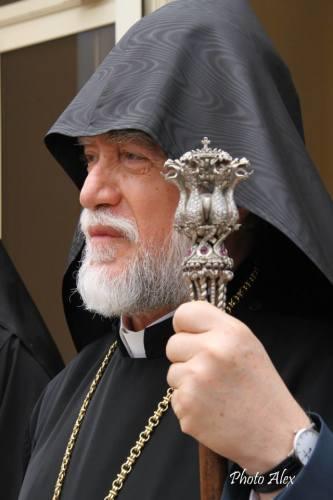Aram I: The Guardian of the Cause – By Dania Ohanian

18/2/15
The international conference on the Armenian Genocide: from recognition to reparation, took place at the Catholicosate of Cilicia, in Antelias, Lebanon, from February 23-25, 2012. The philosophy of such a thought-provoking conference flew academicians from around the world and was organized by His Holiness Aram I, a visionary church leader.
The objective of the conference was to bring experts from around the world to cogitate the legal dimensions of reparations for the Armenian Genocide. Why a religious institution was to organize a conference with a topic on reparations? His Holiness Aram I wrote in the International Criminal Law Review[1] “Human rights are not optional; they are integral to Christianity. What is more, human rights are essential to the vocation of church institutions. Human rights in general and the Armenian Genocide in particular are part of the missionary calling of the Armenian Church and occupy, therefore, an important place on its agenda.”
The conference on “Recognition to Reparation” validated that this indispensable issue is crucial to collectively be addressed in the circles of scholars and specialists.
Armenian Communities around the world are preparing to commemorate the 100th anniversary of the Armenian Genocide on April 24, 2015. The sobering experience of the Genocide, the profound shock will reverberate and hundred years of continued denial will yield on into the future.
In September 2014, His Holiness Aram I shocked the world during his dynamic and courageous speech at the Fifth Armenia-Diaspora Conference in the capital city Yerevan, Armenia. “The Great House of Cilicia will soon petition to Turkey’s Constitutional Court to demand the return of Sis Catholicosate to its owner, namely the Armenian Church and Armenian people. We can not remain indifferent to the violated rights of our nation, as indifference is treason,” His Holiness said. The Catholicos gave the Armenian Nation a hope for the future by bravely announcing that He has chosen to embark on a new challenge with an extraordinary resilience.
The idealistic church leader writes in the International Criminal Law Review “Church properties represent a central and unique place in any reparative process. Both spiritually and culturally, the church has for almost two millennia been at the center of Armenian existence and identity. Thus, the return of church lands and buildings, particularly consecrated churches, is perhaps the most meaningful starting point for the restoration of Armenian identity.”
Far from cause for satisfaction, this claim only highlights the tragedy of a Nation and seeks justice beyond retribution. Is retribution included in Transitional Justice?[2] This petition will make wider claims about the mechanisms of Transitional Justice and will intend to integrate researchers who concentrate on issues of legal transition and institutions and mechanisms of “dealing with the past”.
It is indisputable, that His Holiness Aram I will warmly welcome and encourage any assistance by policy makers addressing decision making and legitimacy issues.
[1] International Criminal Law Review, Volume 14, No. 2, 2014, Special Issue, Armenian Genocide Reparations

446313 680526Hmm is anyone else experiencing difficulties with the images on this blog loading? Im trying to find out if its a problem on my end or if its the weblog. Any feed-back would be greatly appreciated. 571617